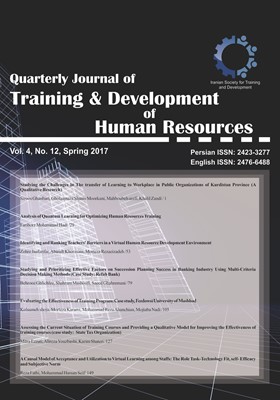-
-
List of Articles
-
Open Access Article
1 - Identifying and Modelling of Challenges for Implementing E-Learning in the Iranian National Gas Company: An Interpretive Structural Modeling (ISM) approach
farzane tari -
Open Access Article
2 - Exploring the Interaction between Mentor & Mentee in Mentoring of New Hired Faculty Members of Universities: Qualitative Approach
kourosh Fathi Vajargah Abasalt khorasani behrooz ghlichlee -
Open Access Article
3 - Identifying and Explaining the Dimensions, Components and Indicators in Competency Development for Banking Industry Managers
hasan asheghi Mohammad Nadergholi GHourchian -
Open Access Article
4 - Structural Modeling of the Impact of Organizational Factors on the Human Resource Development with the Mediating Role of Knowledge Management Process and Transfer of Training
Kolsoom Nami mir mohmmad seyed abbaszadeh Mohammad Hassani Abbas Bazargan -
Open Access Article
5 - Developing the Strategies of Educational Management in Iranian Red Crescent
Fatemeh Narenji thani mehrab sharifi sedeh seyed hamid jamaleddini -
Open Access Article
6 - Injuries, Solutions and a Model for Employees Training System of Islamic Republic of Iran Customs
Morteza Yarahmadi Reza Najafbagy Karamollah Daneshfard Akbar Alamtabriz -
Open Access Article
7 - Identification of Instructional Competency Evaluation Indicators in Tehran Municipality Managers
Maryam Hafezy fatemeh moradi
-
The rights to this website are owned by the Raimag Press Management System.
Copyright © 2017-2026







